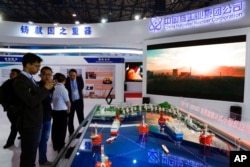China’s planned deployment of floating nuclear reactors to the disputed South China Sea may risk ramping up tensions with other claimants and undermining regional security, and claimants should work through a multilateral framework to counter China, say experts.
China plans to send some 20 floating nuclear power plants to the islands it reclaimed in the South China Sea, where it has long-running territorial disputes with some regional countries, The Washington Post reported early this month.
China claims almost the entirety of the South China Sea as its own despite a ruling by the Permanent Court of Arbitration in 2016 which rejected the claim as “having no legal basis.” Malaysia, Vietnam and the Philippines also have rival claims to some island chains and parts of the sea.
These claimants view China’s planned operation of these reactors as “a direct challenge” to their sovereignty, Pratnashree Basu, associate fellow with the India-based Observer Research Foundation’s Strategic Studies Program, told VOA in an email exchange, if the reactors are deployed to islands, rocks, low-tide elevations, or man-made features they claim.
Basu cited Vietnam’s 2008 Law on Atomic Energy, which requires nuclear-powered vessels in Vietnamese waters to be authorized by the country’s prime minister.
Such regulations do not exist in the Philippines, she noted, but Manila can still “assert its right to monitor [a] Chinese nuclear plant under its maritime laws.”
Since 2014, China has reclaimed land to build artificial islands on some features it controls in the Spratly archipelago which is also claimed by Hanoi and Manila.
“Given Beijing’s record of strengthening its foothold in the South China Sea regardless of international law, the planned deployment of nuclear power plant(s) would potentially bolster Beijing’s grip on the artificial islands it has built and militarized,” she wrote to VOA.
The move risks further ramping up tension in an already tense region, she warned.
Ha Hoang Hop, an associate senior fellow with the Singapore-based ISEAS Yusof Ishak Institute, told VOA that “it doesn’t matter to other claimants if China just sails the floating nuclear plant around the South China Sea.”
“However, if they dock at Spratly or Paracel [another island chain claimed by both Beijing and Hanoi but controlled by Beijing], Vietnam will certainly protest,” Hop said.
He argued that the deployment to islands Vietnam claims “violates Vietnam’s sovereign rights,” noting that such deployment will inevitably support Chinese military and patrol activities in the South China Sea.
“If the plants power Chinese military activities like electrical warfare, reconnaissance, airspace monitoring, drone warfare, among others, they would pose a serious threat to regional security,” he added, warning that if the vessels carry nuclear warhead missiles to the South China Sea, it would constitute a “breach of international law.”
Observer Research Foundation’s Basu noted that floating nuclear power plants can provide energy to China’s offshore oil and gas exploration, and especially military bases.
“Reliable energy also enhances surveillance and rapid-response capabilities,” she added.
Asked what Vietnam and the Philippines can do to counter the Chinese move, Raymond Powell, a team leader at Stanford University's Gordian Knot Center for National Security Innovation, told VOA in an email that he is “not sure there’s an avenue for contesting China’s use of floating nuclear power plants in the South China Sea.”
“China is unlikely to respond to outside pressure to hold off, and it’s not clear it would [be] violating any international law or regulation if it moves forward,” he wrote in the email.
ISEAS Yusof Ishak Institute’s Hop said that other claimants may consider renting nuclear power plants built by Western countries or Russia to deploy in the South China Sea as part of a “tit-for-tat” strategy.
Basu suggested that the claimants and the U.S. work through ASEAN and other regional forums to address concerns about the floating reactors to promote multilateral engagement over unilateral actions.
“Countries could challenge the deployment of floating nuclear power plants in disputed waters through international courts or tribunals, seeking rulings that could limit or regulate their operation,” she wrote.
The countries should also advocate for the application of existing international laws such as the United Nations Convention on the Law of the Sea (UNCLOS) to floating nuclear facilities, she added.
Additionally, according to Basu, building coalitions with global environmental and safety organizations to pressure for stricter regulations of floating nuclear power plants could be an option.














